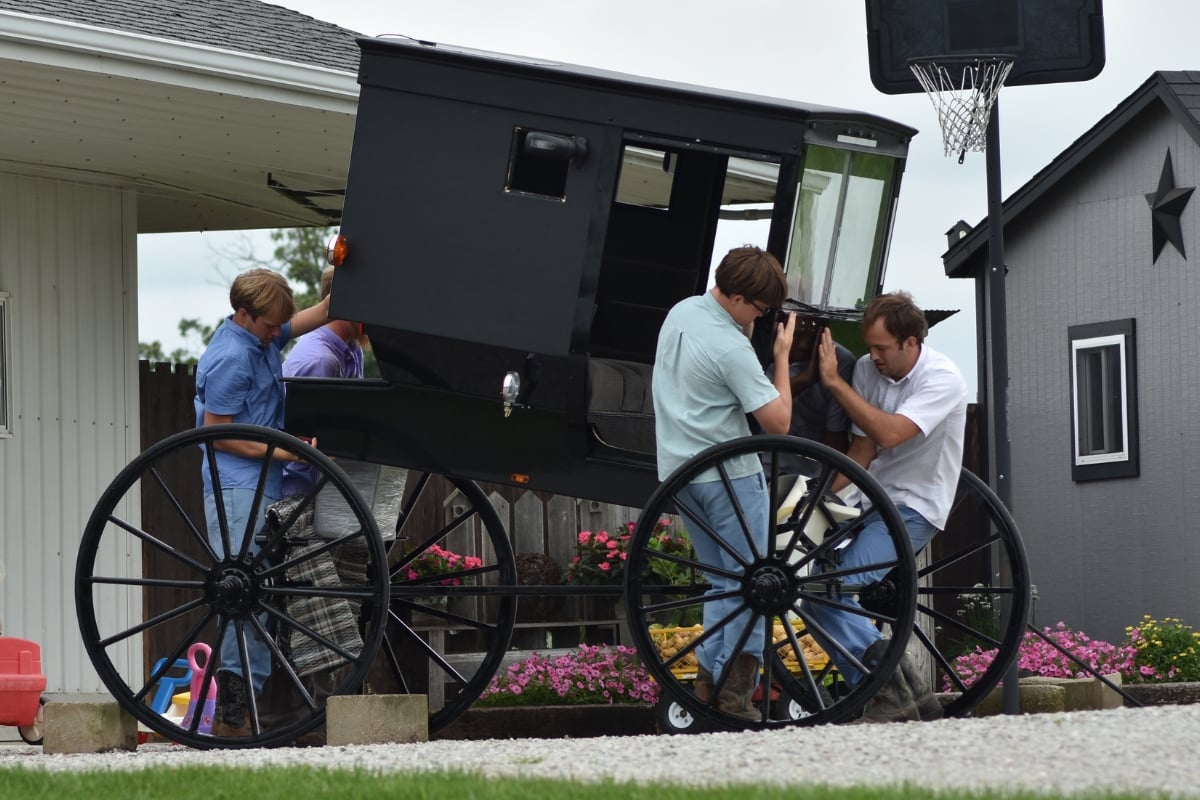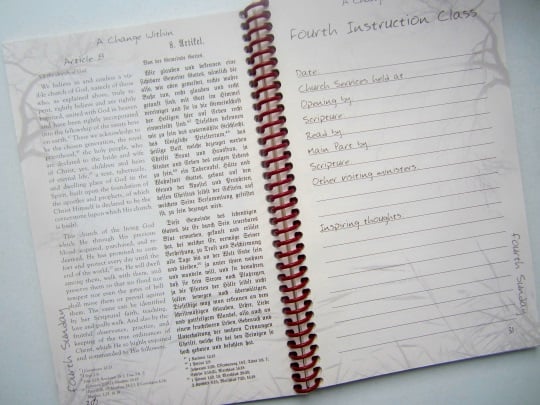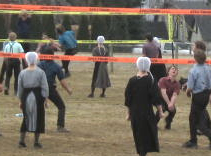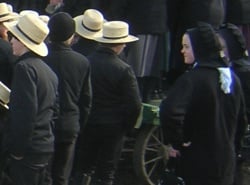Rumspringa & Amish Youth (Myths & Realities) - Amish America (original) (raw)
 What is Rumspringa? Rumspringa is the term used to describe the period of adolescence Amish young people go through starting at age 16. Rumspringa has often been covered in books and films – to varying degrees of accuracy.
What is Rumspringa? Rumspringa is the term used to describe the period of adolescence Amish young people go through starting at age 16. Rumspringa has often been covered in books and films – to varying degrees of accuracy.
There are many misconceptions about Rumspringa. Let’s have a look at what actually happens during Rumspringa and answer some common questions about this important period of Amish life.
- What does Rumspringa mean?
- Rumspringa Myths
- Purpose of Rumspringa
- Amish Youth Groups
- Amish Dating during Rumspringa
- Amish Drug Bust (1998)
- An Amish father’s words on Rumspringa
- When does Rumspringa end?
- Rumspringa FAQ
Rumspringa Meaning
Rumspringa literally means “running around” in the Pennsylvania Dutch language spoken by Amish. When speaking of the period in English, Amish are more apt to describe their youth as “running around” rather than, say, “being in Rumspringa” or some similar description.

Common myths about Rumspringa
The following are all common misconceptions about the Amish & Rumspringa. While there are always exceptions and individual examples, these ideas are for the most part incorrect.
- Amish youth leave home to live in the city – Most Amish live at home while adolescents.
- Amish parents encourage their youth to “break the rules” – Amish parents, like any other, want their children to behave morally.
- Rumspringa is “time out” from being Amish – Most Amish youth live at home and attend church during Rumspringa, and are subject to community influences. However they may bend and break church norms found within the Ordnung (“Amish rules”) as they are not yet church members.
- Rumspringa is typically a time of experimentation with sex and drugs – Some portrayals of Rumspringa have depicted the time as one of wild partying, though this is the exception rather than the norm.

Rumspringa misconceptions
Rumspringa has been portrayed as time of experimentation and decision. While Amish youth will mull the decision to join the church at this time, one Amishman who has studied the subject extensively contends that this decision is typically already made in the mind of many youth.
The Rumspringa period serves other purposes besides deciding whether to join the church, detailed here and below. One of those purposes is to enter into a more formalized social world and peer interaction, which occurs when joining a youth group.
The Purpose of Rumspringa
Rumspringa, according to one Amishman who has studied numerous outside portrayals of the adolescent period, is a time when an Amish youth enters into a more formalized social world. During this period, an Amish young person will interact with others in his or her age group, in a variety of settings.
Amish youth play volleyball at Sunday singings
Rather than an angst-filled period of existential choice, it is primarily “a time to find a marriage partner”. As opposed to a sinful exploration of the world, typical Rumspringa activities are much tamer. They may include attending church singings, participating in games and activities with the Amish call a “buddy bunch” or “gang” (Amish-used terms for youth group) and of course, dating.
Contrary to belief, Amish parents do not “encourage” their youth to leave home and experiment with sinful behaviors—nor do they condone it. At the same time, there must be at least a semblance of free choice in the decision to become Amish.
Amish parents may disapprove of their teens’ behaviors. But they do not necessarily exercise authority to prevent some of those behaviors. It should also be noted that some Amish parents will be more permissive than others, especially those who themselves behaved wildly during their own time “running around”.
Amish Youth Groups
Amish youth groups vary in their character—some “plainer” or slower groups are tamer, and even adult-supervised, while other “faster” groups are less conservative in expectations and rules. Youth groups typically meet on weekends.
In the case of the faster groups, this may mean parties or “band hops”, while with the slower, or “singing” groups as they are called in some communities, meet on Sunday at the home where church service took place for games of volleyball and group singing. The larger Amish communities can have dozens of youth groups, varying in degree of plainness.
Rumspringa is a time of increased social activity for Amish youth
Contrary to portrayals, most Amish do not participate in heavy partying, drug use, premarital sex, or other illicit behaviors—though these are not unheard of, particularly among wilder youth groups. Some Amish boys may acquire a driver’s license and a vehicle during this time. In some cases they might park their vehicles at their parents’ home. One non-Amish person observed:
In Holmes County, some of the kids buy cars. They sell them when they join the church, but they have a lot of fun for a couple of years. It’s funny to look in a car window and see the blue shirt, suspenders, bowl haircut and hat behind the wheel of a Firebird.
Some Amish will fit out their buggies with onboard stereo systems with large speakers. The vast majority of Amish youth, however, do not leave home for the city or even for their own dwelling place within the community, but remain under their parents’ roof until marriage.

Amish youth buggy with a strategically-placed Ford nameplate
Amish Dating
Traditional dating among the Amish follows a common formula. A young man will invite a young woman to drive her home in his buggy after a Sunday singing. A dating couple may exchange letters and will see each other mainly on Sunday. A couple may date for a year or longer before a young man may ask for marriage. He will also seek out the blessing of her parents.
A key purpose of Rumspringa is finding a marriage partner
If all goes to plan, the couple will inform the deacon, who then “publishes” their intent to marry, or in other words, their plans will be announced to the church. Preparations for a wedding will ensue. Though it is not common, some Amish may date non-Amish, which can present complications (Amish do not marry non-Amish, as both partners must be baptized in the Amish church).
Amish drug bust: Rumspringa taken too far?
The 1998 drug bust of two young Lancaster County Amish men for selling cocaine did much to fuel the idea of Rumspringa as a hedonistic, hypocritical period for Amish youth. Two young Amish men pled guilty to conspiracy to sell cocaine, which they had been acquiring from the Pagans motorcycle gang, and selling to other young Amish people as teens. As one would expect, the incident deeply troubled the Amish. The response included anti-drug classes as well as more parental involvement in youth groups, including the formation of some “slower” groups.
Drug use is generally not widely seen among Amish youth (though not unheard of). Nonetheless, the perception of the youth period as a hedonistic time, driven by national coverage of this story as well as by the follow-up 2002 documentary The Devil’s Playground, has stuck. Later media such as the “Breaking Amish” TV series has only further entrenched this perception.

An Amish father’s view of Rumspringa
The following was written by an Amish father. We include it here to give one direct Amish perspective on this important period of Amish life. This Amishman lives in Pennsylvania and is the father of six children.
And now turning to Rumspringa. I’ll try to recap what Rumspringa is and what it is not. What is mythical and what is reality. The reality is at the age of 16 the young begin attending youth gatherings. The purpose of these is to socialize with peers and to find a marriage partner. Once married this period of life is over. The myths are that Rumspringa is the time to decide whether you want to be Amish or not.
That choice is made sometimes earlier than 16 but not acted on until later in the teenage years, or sometimes when one fails to find a marriage partner that person gradually drifts away to another way of life. Then also sometimes the choice to leave the Amish is a result of a mid-life crisis of some sort–happening even after baptism and marriage.
The idea that parents encourage the youth to sample the world with the hope that this inoculates them against the world is very much a myth.
Amish parents like any other parents are very concerned about their children’s behavior and do everything they can to help the young make good choices. The youth are not encouraged to sow their wild oats. When a young person decides to be rowdy and engage in deviant behavior they are making a choice of their own. Certainly not at their parents’ behest or suggestion.
Although the degrees of parental resistance and correction vary some, poor choices and deviant behavior by the youth cause all parents anxiety.
Rumspringa is not a period of temporary freedom. Some of the young are baptized members of the church and as such are accountable for their behavior to the body of believers. This doesn’t mean their behavior is always perfect and always in the Ordnung but nonetheless they are responsible for their actions. Other youth are unbaptized and are not members of the church and as such are not accountable to the church. However they are the children of concerned parents and since the unbaptized are usually in their early to mid teens they are therefore still the responsibility of their parents, who are doing the very best they can to be good parents.
The youth are also learning about peer pressure, some of which is positive, such as that produced by girls seeking decent guys!! And then also some peer pressure as any American teenager knows is not so positive.
In spite of parents’ best efforts it seems the young everywhere sometimes only learn the hard way.
When does Rumspringa end?
Participating in certain social activities as well as the use of unsanctioned technologies ends for many Amish youth at baptism, and at the latest at marriage in the Amish church. Following joining the church, Amish may continue to spend time with their youth group, largely for the purpose of finding a spouse.
Baptism and membership in the church is required of prospective Amish mates, a decision which Amish youth typically take around ages 18-22. Baptism may occur sooner or later, however. Amish girls typically choose to be baptized at a slightly earlier age than boys. Amish youth often maintain close ties with their _Rumspring_a friends, which may last a lifetime.
For more, see:
- Baptism in the Amish Church
- How Do Amish Youth Prepare For Baptism?
- Amish Dating
- At an Amish youth singing
- Do Amish play sports?
- How do Amish youth get driver’s licenses?

Some Amish youth use social media, such as TikTok, Instagram, and Facebook (@johnnydetweiler from the Return to Amish program)
Frequently Asked Questions
Below you’ll find some of the most commonly-asked questions about the Amish & Rumspringa.
- What is the purpose of Rumspringa?
- Are Amish youth encouraged to behave badly during Rumspringa?
- Do youth have to follow the rules during Rumspringa?
- Why is Rumspringa important?
- Do Amish youth leave home during Rumspringa?
- Why do Amish have youth groups?
- What is a “Buddy Bunch”?
- What happens at an Amish youth singing?
- Do Amish youth own smartphones?
- Do Amish get into trouble during Rumspringa?
- What do Amish do on dates?
- What is bundling?

Why do Amish have Rumspringa?
In the words of one Amish father of six boys, “at the age of 16 the young begin attending youth gatherings. The purpose of these is to socialize with peers and to find a marriage partner. Once married this period of life is over.”
It does not explicitly mean a time to “get wild”, “sow oats”, or “taste the world” (even though that is what some Amish youth end up doing). It’s a period in which Amish youth engage in increased social activity, and in most cases it ends with joining the church, marriage, and settling down.
Do Amish encourage youth to be wild during Rumspringa?
No. This is a myth. Amish parents accept that their Rumspringa-age children may test boundaries before deciding to join church. However they do not “encourage” their young to sow wild oats or engage in sinful behavior (not unlike how most non-Amish parents raise their children).

Amish youth often customize their vehicles with reflectors.
As one Amishman says, “When a young person decides to be rowdy and engage in deviant behavior they are making a choice of their own. Certainly not at their parents’ behest or suggestion.”
Do Amish have to “follow the rules” during Rumspringa?
Technically not church members but not completely under the influence of their parents, Amish youth do have leeway to push boundaries.
They do so in various ways. These can include wearing non-Amish clothes and hairstyles, participating in parties and “English” activities, using alcohol and other substances, and even acquiring a driver’s license and vehicle.
It’s important to note that not all Amish youth participate in such ways however, and many if not most Rumspringa experiences are tamer–much tamer–than that depicted in much of the media. Participation in youth and singing groups, sports activities, and taking trips with friends are more common and more acceptable youth behaviors.
Why is Rumspringa important?
Rumspringa is often understood as a time when Amish youth are deciding whether or not to be baptized as Amish church members, a lifelong commitment with tangible implications if broken.
However, as the longstanding trend is that a majority of Amish youth do eventually choose to join the church, this probably overstates the existential nature of this period of life. An Amish father states that, in fact, “that choice is made sometimes earlier than 16 but not acted on until later in the teenage years, or sometimes when one fails to find a marriage partner that person gradually drifts away to another way of life.”
It’s clear that the Rumspringa period is important as a time to find a potential spouse. Since the Amish church requires baptism before marriage can occur, when couples are seriously dating, baptism can in most cases be considered a foregone conclusion.

A Change Within is a pre-baptismal journal for youth as they prepare to join church. It contains the Dordrecht Confession, selections from Scripture, and the Rules of a Godly Life devotional
Do Amish youth leave home during Rumspringa?
This is uncommon, despite portrayals to the contrary in the media. Rumspringa-age youth typically live at home until after joining the church and then getting married and moving into their own homes.
Why do Amish have youth groups?
Youth groups offer Amish adolescents a formal peer group with which to socialize on a regular basis (usually weekly) following church service. The way Amish youth socialize in their groups varies widely though, depending on how “fast” or “slow” their particular group is.
Slower groups revolve around the Sunday evening singing, which is often adult-supervised. Faster groups may engage in parties with live or recorded popular music, alcohol and even drugs. Youth groups may have creative names, such as Lancaster County groups called “Parakeets”, “Cherokees”, and the “Quakers” (see Richard Stevick’s Growing Up Amish: The Rumspringa Years, p. 117-118 for a discussion of the Quakers gang).
Amish parents have encouraged adult-supervised and morally upright activities for their youth, especially following highly-publicized incidents involving Amish youth and drugs. One such initiative among concerned Amish parents in Holmes County, Ohio is known as the “Midway” movement (see An Amish Paradox, p. 74-77).
What is a “Buddy Bunch”?
In some places including the Lancaster County settlement, a Buddy Bunch describes a peer group within a youth group or “gang” as it is known in some places. Donald Kraybill describes the term in The Riddle of Amish Culture as “the cohort of twelve to twenty youth that join a gang in a particular year.” Furthermore, as “the primary peer groups for teens, Buddy Bunches often continue meeting throughout their lives” (see p. 146-147).
What happens at an Amish youth singing?
Youth gather in the afternoon, typically at the home of the family which held church that day. Volleyball games may be played at various nets set up at the property. Dinner is provided, and in the evening a group singing commences, typically lasting around 2 hours.

Youth typically play volleyball before the Sunday singing.
Amish parents and other family may attend, particularly in so-called “supervised” groups. Songs are sung from various hymnbooks, in German and in some cases in English. Participants pass around water and snacks for refreshment during the singing. Following the singing, Amish youth socialize and couples may pair off to leave on dates. Read an outsider’s account of attending an Amish youth singing.
Do Amish use social media?
Some Amish do use smart phones, particularly in more progressive communities. Smartphone use is most common among youth, but adults also use them (or simpler cell phones), particularly business people who find them useful as a tool for management and customer contact.
Since many phones are internet-enabled, some Amish do go online. Some Amish youth do have Facebook, Instagram, TikTok, and other social media accounts. See Richard Stevick’s work Growing Up Amish: The Rumspringa Years for a current account of smartphone and internet use among Amish youth.
Do Amish get into trouble during Rumspringa?
Like other adolescents, some do. Occasionally, bad behavior by Amish youth makes the media. These are typically stories involving parties, underage alcohol possession, and sometimes DUI arrests.
What do Amish do on dates?
Amish dating practices vary by groups. A typical first date is arranged when a young man asks a young lady if he can give her a ride home following a Sunday singing.
Amish teenage boys get their first buggies at a similar time as American males get their first cars – on turning 16. In contrast, young Amish females rarely have their own buggies. Some Amish youth may go on dates in a more “English” style, including going out to eat or attending concerts.
What is “bundling”?
“Bundling” or bed courtship is practiced by some Amish in the plainer communities. Bundling is a colonial-era custom which was historically practiced not only in Amish culture but among non-Amish as well. It is known in the PA Dutch dialect as Uneheliche beischlof.
The practice involves a dating couple laying together on a bed, fully clothed, where they are expected to talk together into the wee hours but abstain from sexual activity. Human nature being what it is, that is not always the case.
Bed courtship is a minority custom with which many Amish will have no experience. Amish may even be embarrassed to be associated with the practice. See Growing Up Amish, p. 229-230 for a more in-depth discussion of bundling.
References:
- Stevick, Richard A. Growing Up Amish: The Rumspringa Years. Baltimore: Johns Hopkins University Press, 2014.
- Hurst, Charles E, and David L. McConnell. An Amish Paradox: Diversity & Change in the World’s Largest Amish Community. Baltimore: Johns Hopkins University Press, 2010.
- Kraybill, Donald B. The Riddle of Amish Culture. Baltimore: Johns Hopkins University Press, 2001.
- “Amish buggy driver charged with DUI.” Associated Press. The Patriot-News/Penn Live, 8 Dec. 2009. Web. Accessed 27 Mar. 2015.



